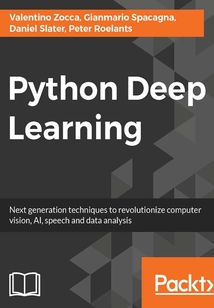目錄(85章)
倒序
- 封面
- 版權(quán)信息
- Credits
- About the Authors
- About the Reviewer
- www.PacktPub.com
- Customer Feedback
- Preface
- Chapter 1. Machine Learning – An Introduction
- What is machine learning?
- Different machine learning approaches
- Summary
- Chapter 2. Neural Networks
- Why neural networks?
- Fundamentals
- Summary
- Chapter 3. Deep Learning Fundamentals
- What is deep learning?
- Deep learning applications
- GPU versus CPU
- Popular open source libraries – an introduction
- Summary
- Chapter 4. Unsupervised Feature Learning
- Autoencoders
- Restricted Boltzmann machines
- Summary
- Chapter 5. Image Recognition
- Similarities between artificial and biological models
- Intuition and justification
- Convolutional layers
- Pooling layers
- Dropout
- Convolutional layers in deep learning
- Convolutional layers in Theano
- A convolutional layer example with Keras to recognize digits
- A convolutional layer example with Keras for cifar10
- Pre-training
- Summary
- Chapter 6. Recurrent Neural Networks and Language Models
- Recurrent neural networks
- Language modeling
- Speech recognition
- Summary
- Bibliography
- Chapter 7. Deep Learning for Board Games
- Early game playing AI
- Using the min-max algorithm to value game states
- Implementing a Python Tic-Tac-Toe game
- Learning a value function
- Training AI to master Go
- Upper confidence bounds applied to trees
- Deep learning in Monte Carlo Tree Search
- Quick recap on reinforcement learning
- Policy gradients for learning policy functions
- Policy gradients in AlphaGo
- Summary
- Chapter 8. Deep Learning for Computer Games
- A supervised learning approach to games
- Applying genetic algorithms to playing games
- Q-Learning
- Q-learning in action
- Dynamic games
- Atari Breakout
- Actor-critic methods
- Asynchronous methods
- Model-based approaches
- Summary
- Chapter 9. Anomaly Detection
- What is anomaly and outlier detection?
- Real-world applications of anomaly detection
- Popular shallow machine learning techniques
- Anomaly detection using deep auto-encoders
- H2O
- Examples
- Summary
- Chapter 10. Building a Production-Ready Intrusion Detection System
- What is a data product?
- Training
- Testing
- Model validation
- Hyper-parameters tuning
- End-to-end evaluation
- Deployment
- Summary
- Index 更新時間:2021-07-02 23:33:02
推薦閱讀
- Java程序設(shè)計(慕課版)
- 程序員面試白皮書
- MySQL 8 DBA基礎(chǔ)教程
- Unity Virtual Reality Projects
- INSTANT Django 1.5 Application Development Starter
- Learning Salesforce Einstein
- BIM概論及Revit精講
- PySide 6/PyQt 6快速開發(fā)與實戰(zhàn)
- C語言程序設(shè)計
- Microsoft 365 Certified Fundamentals MS-900 Exam Guide
- QPanda量子計算編程
- TypeScript圖形渲染實戰(zhàn):2D架構(gòu)設(shè)計與實現(xiàn)
- Mastering OpenStack
- Android初級應(yīng)用開發(fā)
- 編程的原則:改善代碼質(zhì)量的101個方法
- Python數(shù)據(jù)可視化之matplotlib實踐
- Java Web程序員面試筆試寶典
- Learning Behavior:driven Development with JavaScript
- INSTANT Jsoup How-to
- UG 12.0數(shù)控編程實例教程
- Unity 4.x Game Development by Example Beginner's Guide
- SQL編程思想:基于5種主流數(shù)據(jù)庫代碼實現(xiàn)
- C#從入門到精通(第7版)
- 自動化測試實戰(zhàn):基于TestNG/JUnit/Robot Framework/Selenium
- C#程序設(shè)計教程
- Python基礎(chǔ)及應(yīng)用
- Python工匠:案例、技巧與工程實踐
- Python數(shù)據(jù)分析與數(shù)據(jù)化運營(第2版)
- D Web Development
- The Applied SQL Data Analytics Workshop


